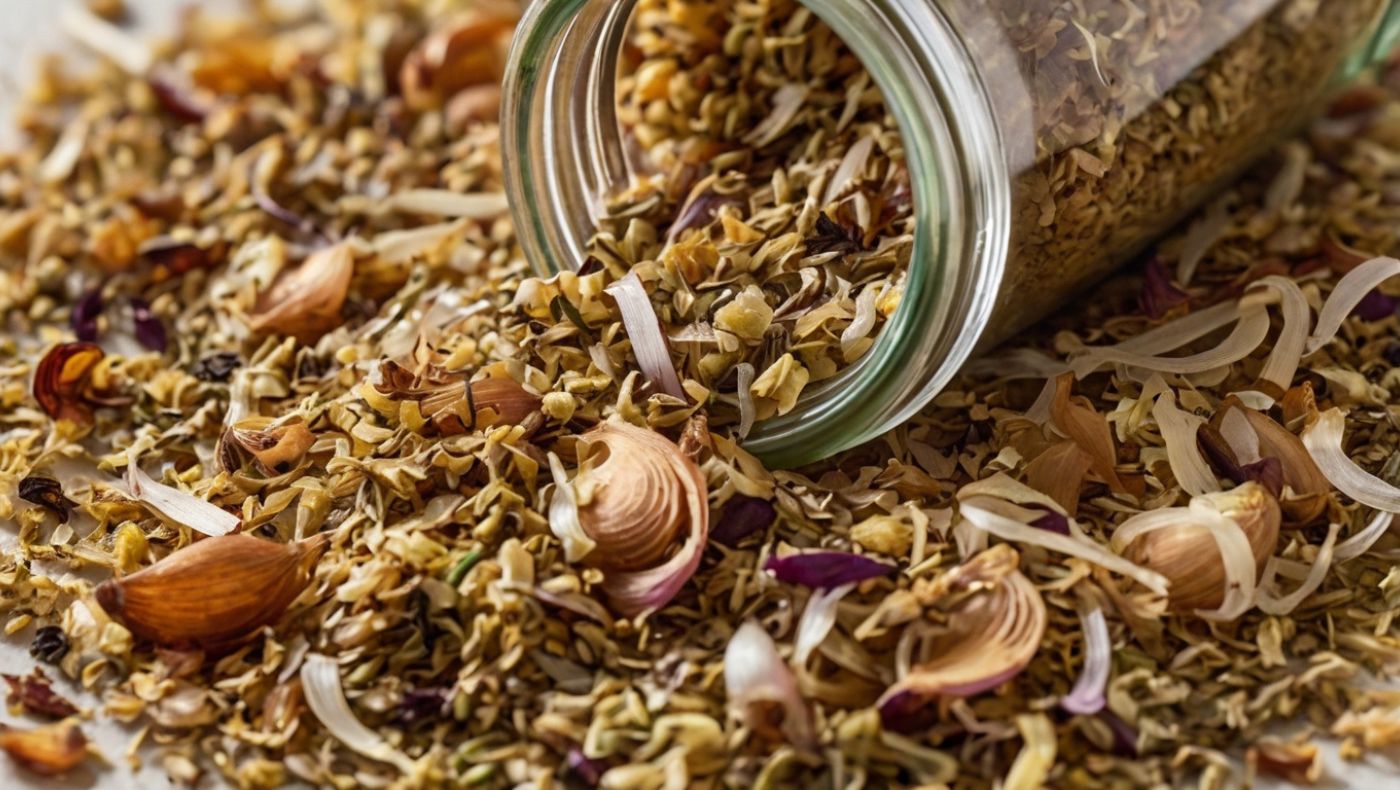Tired of store-bought mixes packed with additives and salt? Homemade Dry Onion Soup Mix is your cleaner, tastier solution. It’s made with simple pantry ingredients, no preservatives, no guesswork. In just five minutes, you can blend your own seasoning that’s perfect for soups, dips, gravies, and more.
Homemade Dry Onion Soup Mix isn’t just easy, it’s incredibly versatile and budget-friendly. Store it in a jar, and it’s ready whenever you need a flavor boost. This mix was a staple in my mom’s kitchen, and now it’s one in mine.
In this post, you’ll learn how to make Homemade Dry Onion Soup Mix, store it properly, and use it creatively to elevate everyday meals, no mystery ingredients, just real flavor.
Why Homemade Makes All the Difference
Commercial onion soup mixes are engineering marvels designed for shelf stability and cost efficiency, not flavor complexity. They rely heavily on salt and MSG for punch, while actual onion content often takes a backseat to fillers and preservatives. Don’t get me wrong, MSG has its place in professional kitchens, but it shouldn’t be doing all the heavy lifting.
When you make your own blend, you control the sodium content completely. More importantly, you can layer in aromatics that commercial versions simply can’t accommodate due to packaging constraints. Fresh ground spices versus year old pre ground ones? There’s no comparison in terms of volatile oil content and flavor impact.
The texture difference is equally dramatic. Store bought versions often include modified food starch and other thickening agents that can create an almost gluey mouthfeel in delicate applications. Your homemade version will integrate more naturally into broths and sauces, providing body without that artificial thickness.
Ingredients & Smart Substitutions for Dry Onion Soup Mix
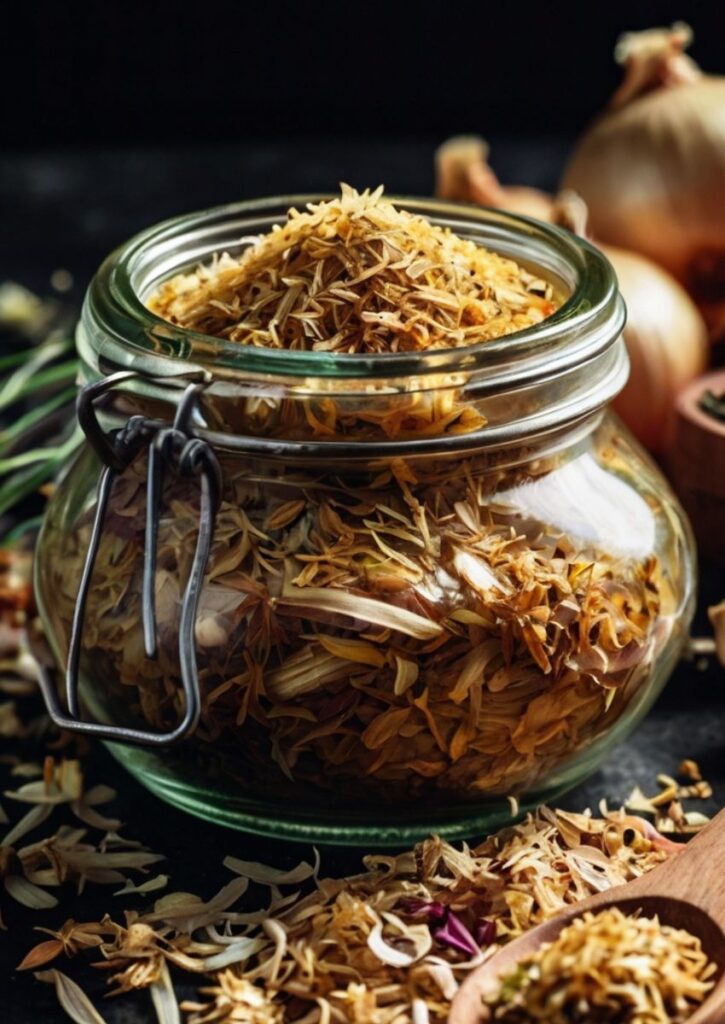
Primary Aromatics:
- 6 tablespoons dried minced onion (the foundation of everything)
- 2 tablespoons onion powder (doubles down on allium flavor)
- 1 tablespoon garlic powder (avoid granulated powder integrates better)
Umami Builders:
- 2 tablespoons beef bouillon powder (Better Than Bouillon works excellently)
- 1 tablespoon mushroom powder (grind dried porcini or shiitake)
- 1 teaspoon celery seed, ground fine
Supporting Players:
- 2 teaspoons kosher salt (Diamond Crystal preferred for clean flavor)
- 1 teaspoon freshly ground black pepper
- 1 teaspoon dried parsley flakes
- ½ teaspoon turmeric (for color and subtle earthiness)
- ¼ teaspoon paprika (sweet, not smoked)
The beauty of this base formula lies in its flexibility. Vegetarians can substitute mushroom or vegetable bouillon powder for the beef base just increase the mushroom powder slightly to maintain that savory depth. If you’re avoiding salt altogether, try doubling the celery seed and adding a tablespoon of nutritional yeast for umami complexity.
For those dealing with onion sensitivities, leek powder makes an excellent substitute, though you’ll need about 25% more since it’s milder. Some cooks swear by adding a pinch of asafoetida (hing) for that authentic onion bite without the actual onions just go easy, as this spice is incredibly potent.
The mushroom powder deserves special mention because it’s often overlooked in home kitchens. You can buy it pre made, but grinding your own dried mushrooms in a spice grinder creates a fresher, more complex flavor profile. Porcini adds earthiness, shiitake brings smokiness, and even basic button mushrooms contribute significant umami when concentrated.
Step by Step Preparation
The Foundation Phase
Start by checking your dried minced onion for freshness it should still have some pliability and a strong onion aroma. If it’s completely brittle and flavorless, replace it. This ingredient makes up nearly half your mix, so quality matters tremendously.
Measure all your dry ingredients into a large mixing bowl, but don’t combine them yet. This staging approach lets you adjust ratios if needed and prevents the smaller spices from settling to the bottom during mixing.
The Integration Process
Begin by whisking together all the powdered ingredients first onion powder, garlic powder, bouillon powder, and turmeric. This creates your flavor base and ensures even distribution of the finer particles. The turmeric tends to clump if added directly to the whole mix, so this step is crucial for color consistency.
Next, add your dried minced onion and parsley flakes. Use a fork to break up any clumps in the minced onion they should separate easily if fresh. Finally, incorporate the celery seed and paprika, whisking everything together until completely uniform.
Quality Control Check
Before storing, perform what I call the “spoon test.” Take a small spoonful and taste it directly. The flavor should be intense but balanced strong onion presence, noticeable but not overwhelming salt, and a pleasant aromatic backdrop. If it tastes flat, add more celery seed. Too salty? Dilute with additional onion powder and parsley.
The mixture should feel relatively fine when rubbed between your fingers, with the minced onion providing the only real texture variation. If everything feels gritty, your spices might be too old or you may need to pulse the mixture briefly in a food processor.
Storage and Shelf Life Mastery
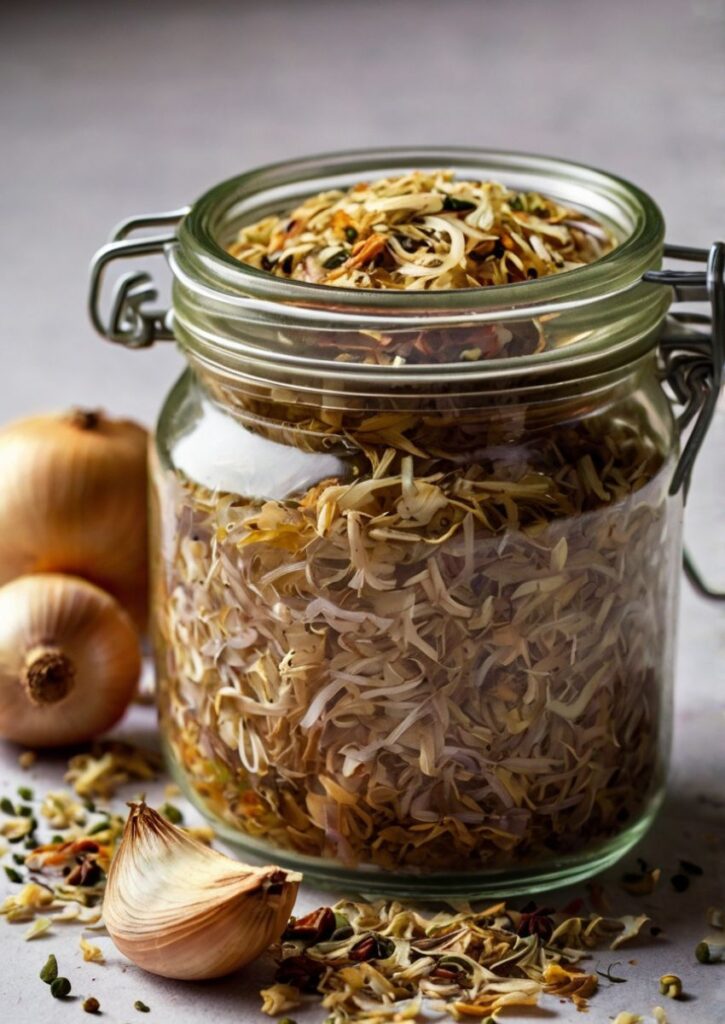
Proper storage turns your homemade dry onion soup mix from a weekend project into a long term pantry solution. Transfer it to airtight glass jars, they don’t absorb odors and let you see the contents. Plastic spice containers work short-term but aren’t ideal for preserving flavor.
Label jars with the prep date and usage tips, six months later, you’ll thank yourself for not confusing it with that experimental taco blend.
Store in a cool, dark place away from heat. Skip the cabinet above the stove, temperature swings degrade flavor. A pantry shelf or cool basement is best for maximum shelf life..
Freshness Indicators
Properly stored, your mix should maintain peak flavor for 12-18 months. However, check it periodically by giving it a sniff the aroma should remain robust and complex. If it starts smelling dusty or flat, it’s time for a fresh batch.
The color will fade gradually over time, which is normal. However, if you notice any clumping or moisture absorption, check your storage container’s seal. Moisture is the enemy of spice blends, leading to caking and potential spoilage.
Professional Applications Beyond Soup
While this homemade dry onion soup mix excels at creating rich, flavorful onion soups, limiting it to that single use is like using a chef’s knife only to chop onions. The versatile flavor profile of this Dry Onion Soup Mix makes it incredibly useful in soups, casseroles, stews, marinades, and even homemade spice blends for everyday cooking.
Marinade Base
Mix 2 tablespoons of your blend with ¼ cup olive oil and 2 tablespoons red wine vinegar for an instant marinade that works beautifully with beef, pork, or even hearty vegetables like portobello mushrooms. The combination of acids and aromatics breaks down proteins while infusing deep flavor.
Seasoning Rub for Roasted Proteins
Applied directly to chicken skin before roasting, this blend creates an incredibly flavorful crust while the rendered fat carries the aromatics throughout the meat. Use about 1 tablespoon per pound of protein, applied 30 minutes before cooking to allow the salt to penetrate.
Vegetable Enhancer
Toss roasted vegetables with a light coating of oil and 1-2 teaspoons of the mix before they hit the oven. Root vegetables particularly benefit from this treatment the onion flavors complement their natural sweetness while adding savory complexity.
The Science Behind the Blend
Why does this homemade dry onion soup mix work so well? It’s all about layered onion flavor, dried minced onion, onion powder, and garlic powder each add unique depth. This “flavor redundancy” builds a fuller taste than any single ingredient can.
Dried minced onion adds texture and rehydrated bursts of flavor. Onion powder evenly blends through liquids, while garlic powder adds pungency and bridges sharp and sweet notes in this natural onion soup mix recipe
Bouillon powder brings more than salt, it delivers umami richness that enhances all other flavors, making the dry soup mix taste complex and satisfying.
Celery seed balances with a slight bitterness, and turmeric offers warmth and color. These natural spice blend ingredients round out the profile, preventing fatigue in long cooked dishes and giving this onion soup seasoning a delicious, layered finish.
Troubleshooting Common Issues
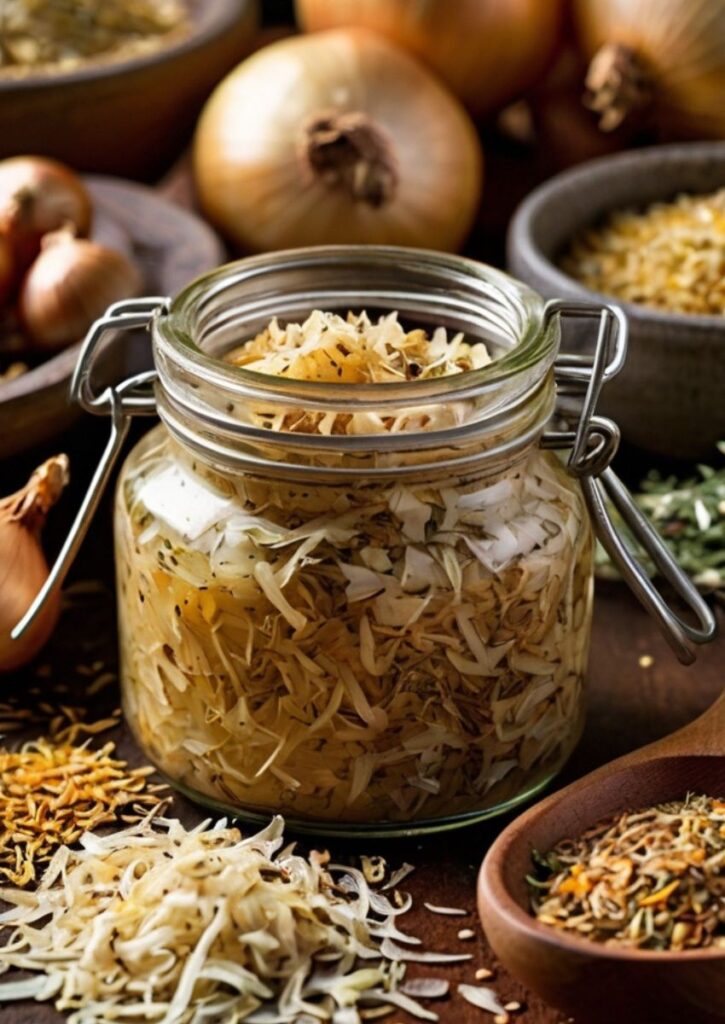
Problem: Mix tastes too salty This usually happens when using table salt instead of kosher salt, or when your bouillon powder is particularly sodium heavy. Solution: dilute with additional onion powder, parsley, and a touch of mushroom powder to rebalance.
Problem: Flavors seem muted in finished dishes Often caused by adding the mix too late in the cooking process. These dried ingredients need time and liquid to fully bloom. Add early in braises and stews, or create a slurry with liquid before incorporating into quick cooking dishes.
Problem: Texture is gritty or sandy Usually indicates old spices or insufficient mixing. Try pulsing the mixture briefly in a food processor, but be careful not to powder the minced onion completely you want that textural element.
Problem: Color is uneven or blotchy Turmeric clumping is the usual culprit. Always whisk it with other powdered ingredients first, and consider sifting the entire mixture through a fine mesh strainer if problems persist.
Creative Variations for Different Cuisines
Mediterranean Version Replace half the parsley with dried oregano and add 1 teaspoon of dried thyme. Include a pinch of dried rosemary, crushed fine. This variation works beautifully in Greek style braised dishes and pairs well with lamb.
Asian Inspired Adaptation Substitute the beef bouillon with dashi powder or mushroom bouillon, add 1 teaspoon of ground ginger, and include a pinch of five spice powder. Reduce the celery seed slightly to let the other aromatics shine.
Southwestern Twist Add 1 teaspoon of ground cumin, ½ teaspoon of mild chili powder, and a pinch of oregano (Mexican variety if available). This version transforms basic pot roasts into something that tastes like it belongs in a Santa Fe kitchen.
Serving and Pairing Excellence
The classic application French onion soup showcases this mix at its finest. Use 3 tablespoons per quart of beef stock, simmer for 20 minutes to allow flavors to meld, then finish with sherry and proper Gruyère cheese. The homemade mix creates a more nuanced broth than commercial versions ever could.
For everyday applications, try mixing 2 tablespoons into ground beef for incredibly flavorful burgers, or whisking it into sour cream for an elevated chip dip that actually tastes like onions instead of salt and chemicals.
The mix pairs exceptionally well with robust red wines the sulfur compounds in onions create interesting flavor bridges with the tannins in wines like Cabernet Sauvignon or Syrah. For lighter applications, consider how the herbaceous notes complement Sauvignon Blanc or even a crisp lager beer.
Professional Storage Tips
Commercial kitchens often store spice blends like homemade dry onion soup mix in portion controlled containers to maintain consistency across multiple cooks. Consider dividing your batch into several smaller containers, one for everyday use and others for backup storage. This prevents contamination and helps preserve the flavor and freshness of your dry soup mix for longer.
Write the onion soup mix recipe ratios directly on your storage container labels. When you’re running low and need to make a quick partial batch, you won’t need to hunt down the original recipe. I’ve seen too many talented cooks recreate mediocre versions of their own dry seasoning blends simply because they couldn’t remember the exact proportions.
Vacuum sealing your dry onion soup mix portions for long term storage extends shelf life significantly, especially if you live in a humid climate. Those small vacuum sealed bags stack efficiently and can be labeled with both contents and preparation dates, keeping your homemade spice mix organized and ready to use.
Cost Analysis and Efficiency of Homemade Dry Onion Soup Mix
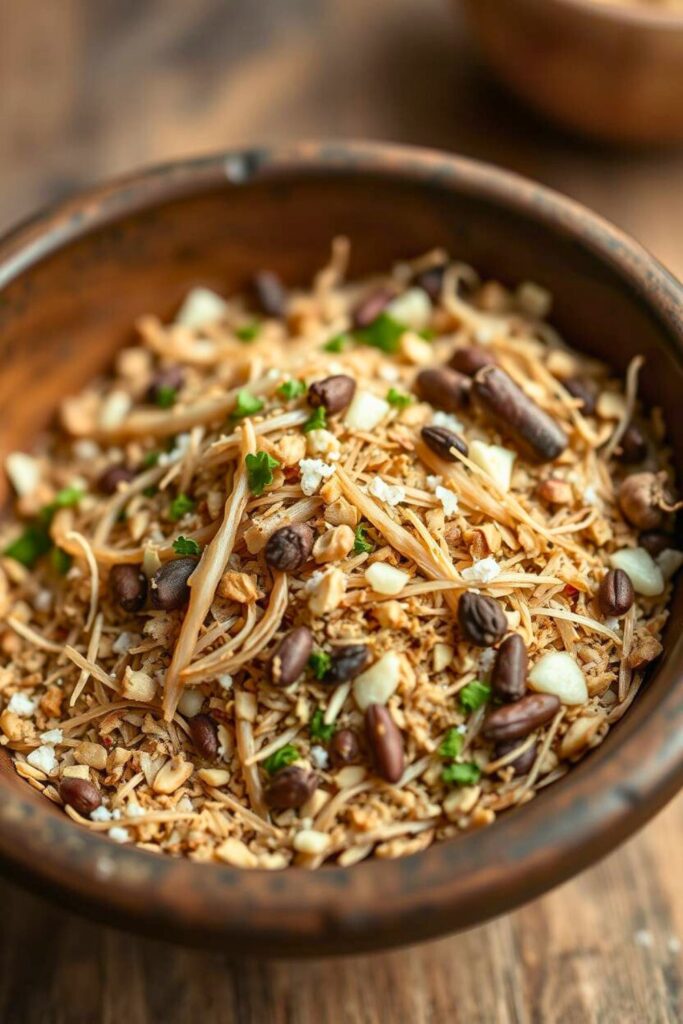
Breaking down the economics reveals why professional kitchens should always make their own blends. A typical 2 ounce packet of commercial onion soup mix costs $1-2 and contains maybe 30¢ worth of actual ingredients. Your homemade version costs roughly 40¢ per equivalent portion while delivering superior flavor and customization options.
More importantly, you eliminate the supply chain dependency that can disrupt menu consistency. When your preferred brand changes formulations or becomes unavailable, your dishes suffer. With homemade blends, you control every variable.
The time investment about 15 minutes for a batch that lasts months represents one of the highest return on investment activities in any kitchen. Compare that to the time spent running to the store for packets or dealing with inconsistent results from different commercial brands.
Mastering the art of homemade spice blends starts with understanding that great cooking isn’t about complexity it’s about controlling quality at every level. This Homemade Dry Onion Soup Mix represents that philosophy perfectly: simple ingredients, thoughtfully combined, creating something greater than the sum of its parts.
The difference between professional and amateur cooking often comes down to these foundational elements. When you make your own blends, you’re not just saving money or avoiding preservatives you’re developing a deeper understanding of how flavors work together. That knowledge transfers to every other aspect of your cooking.
Start with this basic formula, then experiment with the variations until you find your signature blend. Write down what works, note what doesn’t, and build your personal flavor library one blend at a time. Your future self will thank you every time you reach for that jar instead of tearing open another foil packet.
The restaurant industry thrives on consistency, but the best kitchens achieve that consistency through understanding, not shortcuts. Making your own Homemade Dry Onion Soup Mix is a small step toward that understanding, but it’s a step in exactly the right direction.
Frequently Asked Questions
Q: How long does homemade onion soup mix actually last compared to store bought versions?
A: When stored properly in airtight containers away from heat and light, your homemade mix maintains peak flavor for 12-18 months, compared to the 2-3 year shelf life of commercial versions. However, the homemade version tastes significantly better throughout its entire lifespan, while commercial mixes often taste stale long before their expiration dates. The trade off in longevity is more than worth it for the superior flavor quality.
Q: Can I make this mix salt free for dietary restrictions?
A: Absolutely, though you’ll need to compensate for the missing flavor impact. Replace the salt and bouillon powder with additional mushroom powder, nutritional yeast, and a touch more celery seed. Consider adding a small amount of citric acid powder to provide the brightness that salt normally contributes. The result won’t be identical, but it will be delicious and much more flavorful than commercial salt free alternatives.
Q: What’s the best ratio for using this mix in recipes that call for commercial onion soup mix packets?
A: Use 3 tablespoons of your homemade mix to replace one standard 1-ounce packet of commercial mix. Since your blend is likely less salty than commercial versions, taste and adjust seasoning in your final dish. For dips and cold applications, let the mix hydrate in liquid for at least 10 minutes before serving to allow the dried onion pieces to soften properly.
Q: My mix keeps clumping together what am I doing wrong?
A: Clumping usually indicates moisture absorption, either from humid storage conditions or from ingredients that weren’t completely dry when mixed. Add a few grains of raw rice to your storage container to absorb excess moisture, ensure your container is truly airtight, and store in the coolest, driest location available. If your dried minced onion feels at all soft or pliable, it may be too moist for long term storage blends.
Q: Can I scale this recipe up for commercial kitchen use?
A: Yes, this recipe scales perfectly for larger batches. For commercial applications, consider investing in a small spice grinder to ensure consistent particle size across larger quantities, and always make a small test batch first when scaling up significantly. Store large batches in multiple smaller containers rather than one huge container to minimize exposure to air and contamination during daily use.

Swiftly Captions by Tina Smith — Quick, flavorful food recipes made simple, bringing fresh inspiration to your kitchen every day
